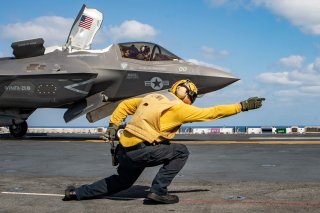Chris Kobel

The United States military is surging its presence in the Middle East again. In the aftermath of Hamas’ shocking October 7 attack and the onset of the Israel-Hamas war, the United States has deployed a truly significant volume of military assets to the region, including two aircraft carrier strike groups, each comprising eight to nine squadrons of attack and support aircraft and a handful of guided missile cruisers and destroyers; additional F-15, F-16, and A-10 fighter aircraft; and a THAAD missile defense system and several Patriot missile defense batteries (accompanied by 900 additional troops to operate them). These assets are further supported by the two amphibious assault ships carrying 3,000 marines and sailors that deployed to the Middle East in early August.
This is something of an unpleasant pattern for the United States: In alignment with Washington’s foreign policy pivot to the Asia-Pacific region, multiple presidential administrations have sought to minimize the U.S. military’s presence in the Middle East, only to be drawn back in by sporadic regional security concerns.
In the past few years, the U.S. military’s reassertions of strength have mainly focused on countering Iranian actions, such as the harassment of commercial vessels in the Strait of Hormuz and attacks conducted by Iranian-backed militias against American military personnel and installations in Iraq and Syria.
Significant escalations, such as the assassination of Islamic Revolutionary Guard Corps (IRGC) Quds Force Commander Qassem Solemani, also required the United States to firmly project power. But these incidents pale in comparison to the sheer display of military strength that the United States has demonstrated amid the present crisis, one of the most significant challenges to regional stability since the rise of ISIS.
But what will this all mean for the future of the U.S. military in the region? Our partners in the Middle East previously understood that, although the United States had no intention of abandoning its security guarantees, it sought to reduce its overall physical military presence and replace it with greater regional integration and cooperation on security matters. Now, the calculus is even more complicated.
Countries like the United Arab Emirates and Saudi Arabia may see this present crisis as proof that the United States is still willing to flex its military might to protect regional stability at large. American troops and warships have been instrumental in deterring Iranian-backed groups such as Hezbollah and the Houthis from significantly escalating their attacks against Israel or opportunistically striking other U.S. allies. The U.S. military’s robust posture has also discouraged Iran from directly involving itself in the conflict beyond its proxies.
However, the past two months are unlikely to have assuaged Riyadh and Abu Dhabi’s concerns that the United States is unwilling to go to bat for its Arab security partners to the same extent that it does for Israel. In other words, is unwavering American military support as readily available to these countries in a time of need as it is for Israel? The answer, to them, probably remains unclear. Out of all of the U.S. Gulf allies, Saudi Arabia has come closest to receiving such assurances:. Prior to October 7, the kingdom was in the midst of intense negotiations with the United States in which it hoped, among other benefits, to obtain American security guarantees on par with those offered to Israel in return for normalizing relations with the country. Such negotiations are, understandably, on pause.
All of this is not to say that the United States’ goal of reshaping its role in the Middle East from sole security guarantor to security partner is in complete jeopardy. The path to reducing the American military’s physical footprint in the region is simply much messier. In early November, American officials asserted that the Saudis remained interested in pursuing normalization with Israel, a step that is critical for unlocking greater regional security cooperation and integration. If, in fact, they remain interested, it’s still unclear when talks can restart in earnest, as Saudi leadership will have to wait for the near-universal public outrage against Israel in the kingdom to lessen. How and when the Israel-Hamas war concludes will also determine the prospects of further Arab normalization with Israel, as well as the ease with which the critical Israeli security partnerships with Egypt and Jordan can be repaired.
The somewhat open-ended nature of the United States’ significant post-October 7 deployment of ships, troops, and other equipment to the region also clearly complicates matters. Will the United States maintain this level of military presence in the Middle East as long as the Israel-Hamas war continues, despite there being no clear end in sight? Either way, the U.S. government will have to communicate to its partners that its impressive array of military assets currently in the region is neither a permanent security measure nor an excuse for defense cooperation efforts to lose momentum. After all, such efforts are central to the U.S. military’s “exit strategy” for the region. It cannot, and should not, overwhelmingly minimize its physical presence until the safety of our allies and partners is assured via an architecture of comprehensive mutual security cooperation supported, but not dominated, by the United States. But in order for such an outcome to be achieved, the U.S. government must remain steadfastly engaged in supporting and advancing all forms of regional security integration and capacity building, no matter how challenging that may be in this post-October 7 world.
No comments:
Post a Comment